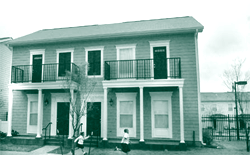June 2008
In this Issue
Black Colleges and Universities Lend a Helping Hand
Learning To House the Homeless
Researching HUD's Housing Programs
What We Know About LIHTCs
In the next issue of ResearchWorks
Researching HUD's Housing Programs
Cityscape recently featured a symposium of research on HUD’s housing programs and the 4.3 million households that participate in them. Just under 1 million households live in traditional public housing, managed by some 3,200 local public housing agencies (PHAs); 1.4 million are in HUD-subsidized, privately owned multifamily projects; and 1.9 million households take part in the Housing Choice Voucher Program (HCVP — formerly known as tenant-based Section 8). This array of programs is fostered by policies introduced in recent decades and is intended to: (1) bring more flexibility, choice, and mobility to housing assistance recipients, making it possible for them to respond to a wider range of employment and other opportunities; and (2) enable more of these households to live in areas with less poverty concentration and racial segregation.
The symposium papers represent a sampling of research questions, theoretical tools, and methodologies that help us better understand how housing assistance programs perform. Perhaps more importantly, the results of this research inform public discussion about housing policy. Several papers respond to the larger question of what shapes resident decisions surrounding housing choice vouchers; the abstracts below reflect the type of research stimulated by these concerns.
Portability Moves in the Housing Choice Voucher Program (HCVP), 1998–2005

Portability in the HCVP enables a household to use a voucher issued in one jurisdiction when moving to another jurisdiction administered by a different PHA. This study of portability moves made from 1998 to 2005 finds that, of the 3.4 million households receiving housing vouchers, 8.9 percent made a portability move. Three-fifths of the moves were made to lower cost jurisdictions, compared with the originating jurisdictions. The data also show reductions in census tract poverty rates and other neighborhood indicators for households that completed portability moves.
The Role of Social Networks in Making Housing Choices
This article explores the experiences of participants in the Gautreaux Two housing mobility program, implemented in 2002. The program gave low-income residents of Chicago public housing a special voucher enabling them to move to more advantaged neighborhoods. Comparing secondary movers with those who stayed at their Gautreaux placement addresses, researchers found that some residents moved or stayed because of social network factors, such as feelings of social isolation in the placement neighborhood, distance from kin, and transportation difficulties. Strong social networks explained why some families remained in their Gautreaux neighborhoods or moved on to other neighborhoods. The analysis explores policy implications for the success of mobility programs, including the need for continued assistance to build and maintain strong social networks beyond the initial placement.
Measuring the Deconcentration of Housing Choice Voucher Program Recipients in Eight U.S. Metropolitan Areas Using Hot Spot Analysis
This article analyzes the clustering of HCVP recipients. Hot spot (density) analysis conducted in eight metropolitan areas (New York, Baltimore, Chicago, Cincinnati, Miami, Houston, Los Angeles, and Phoenix) indicated that clustering of HCVP households varies by metropolitan area. Although HCVPs are becoming less densely concentrated in Chicago and Phoenix, the opposite is true in other metropolitan areas, notably in New York, Cincinnati, and Baltimore. The authors conclude that HCVP concentration is likely to continue as long as affordable rental housing is confined largely to central cities and older inner suburbs.
Household Life Cycle and Length of Stay in Housing Assistance Programs
This study explores factors associated with a household's length of stay in the HCVP. It focuses on how the presence of children of varying ages affects longevity and the degree to which older children, as a potential source of childcare, may mitigate a longer duration of housing assistance. After controlling for an array of household and location characteristics, the main finding was that the presence of an infant or toddler increased a household’s length of stay. The presence of other children in the same household may attenuate or magnify this effect, depending on the presence of teenagers, especially males.
Are Census Variables Highly Correlated with Housing Choice Voucher Holders' Perception of the Quality of their Neighborhoods?
This research analyzed voucher holders' ratings of their neighborhoods on HUD's HCVP Customer Satisfaction Survey. Researchers found that voucher holders’ neighborhood ratings were consistent with their answers to more specific survey questions about attributes of their neighborhoods, such as crime problems and physical disarray, but they were only weakly correlated with census-based measures of neighborhood quality. In addition, combining multiple census variables into a neighborhood quality indicator only marginally increased the explanatory power.
The full text of these and other symposium articles in Cityscape, vol. 10, no. 1 can be read and downloaded at www.huduser.gov/periodicals/cityscape.html or ordered in print by calling 800.245.2691.

